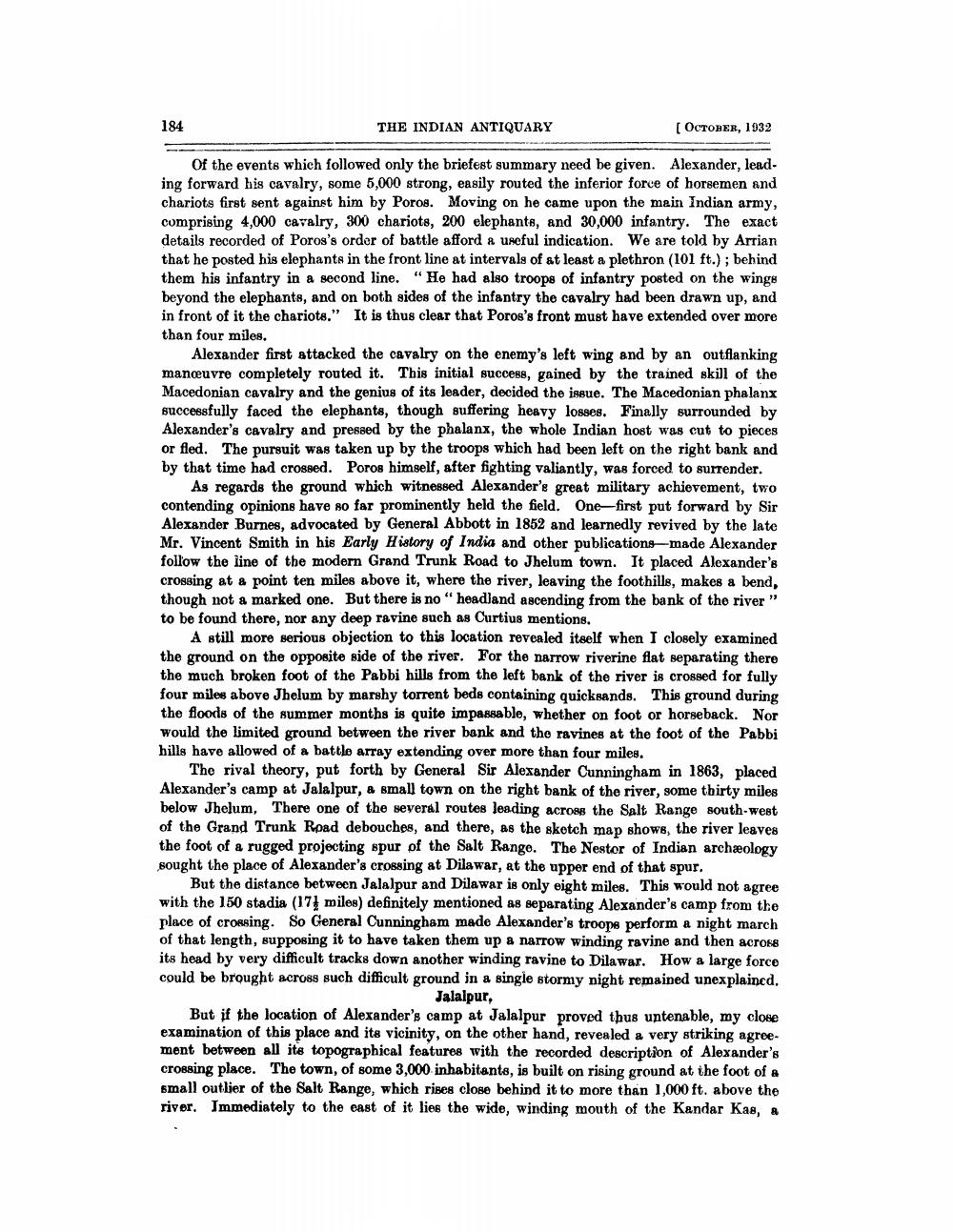________________
184
THE INDIAN ANTIQUARY
[ OCTOBER, 1932
Of the events which followed only the briefest summary need be given. Alexander, leading forward his cavalry, some 5,000 strong, easily routed the inferior force of horsemen and chariots first sent against him by Poros. Moving on he came upon the main Indian army, comprising 4,000 cavalry, 300 chariots, 200 elephants, and 30,000 infantry. The exact details recorded of Poros's order of battle afford a useful indication. We are told by Arrian that he posted his elephants in the front line at intervals of at least a plethron (101 ft.); behind them his infantry in a second line. "He had also troops of infantry posted on the wings beyond the elephants, and on both sides of the infantry the cavalry had been drawn up, and in front of it the chariots." It is thus clear that Poros's front must have extended over more than four miles.
Alexander first attacked the cavalry on the enemy's left wing and by an outflanking manœuvre completely routed it. This initial success, gained by the trained skill of the Macedonian cavalry and the genius of its leader, decided the issue. The Macedonian phalanx successfully faced the elephants, though suffering heavy losses. Finally surrounded by Alexander's cavalry and pressed by the phalanx, the whole Indian host was cut to pieces or fled. The pursuit was taken up by the troops which had been left on the right bank and by that time had crossed. Poros himself, after fighting valiantly, was forced to surrender.
As regards the ground which witnessed Alexander's great military achievement, two contending opinions have so far prominently held the field. One-first put forward by Sir Alexander Burnes, advocated by General Abbott in 1852 and learnedly revived by the late Mr. Vincent Smith in his Early History of India and other publications-made Alexander follow the line of the modern Grand Trunk Road to Jhelum town. It placed Alexander's crossing at a point ten miles above it, where the river, leaving the foothills, makes a bend, though not a marked one. But there is no "headland ascending from the bank of the river " to be found there, nor any deep ravine such as Curtius mentions.
A still more serious objection to this location revealed itself when I closely examined the ground on the opposite side of the river. For the narrow riverine flat separating there the much broken foot of the Pabbi hills from the left bank of the river is crossed for fully four miles above Jhelum by marshy torrent beds containing quicksands. This ground during the floods of the summer months is quite impassable, whether on foot or horseback. Nor would the limited ground between the river bank and the ravines at the foot of the Pabbi hills have allowed of a battle array extending over more than four miles.
The rival theory, put forth by General Sir Alexander Cunningham in 1863, placed Alexander's camp at Jalalpur, a small town on the right bank of the river, some thirty miles below Jhelum, There one of the several routes leading across the Salt Range south-west of the Grand Trunk Road debouches, and there, as the sketch map shows, the river leaves the foot of a rugged projecting spur of the Salt Range. The Nestor of Indian archæology sought the place of Alexander's crossing at Dilawar, at the upper end of that spur.
But the distance between Jalalpur and Dilawar is only eight miles. This would not agree with the 150 stadia (17 miles) definitely mentioned as separating Alexander's camp from the place of crossing. So General Cunningham made Alexander's troops perform a night march of that length, supposing it to have taken them up a narrow winding ravine and then across its head by very difficult tracks down another winding ravine to Dilawar. How a large force could be brought across such difficult ground in a single stormy night remained unexplained. Jalalpur,
But if the location of Alexander's camp at Jalalpur proved thus untenable, my close examination of this place and its vicinity, on the other hand, revealed a very striking agreement between all its topographical features with the recorded description of Alexander's crossing place. The town, of some 3,000 inhabitants, is built on rising ground at the foot of a small outlier of the Salt Range, which rises close behind it to more than 1,000 ft. above the river. Immediately to the east of it lies the wide, winding mouth of the Kandar Kas, &




